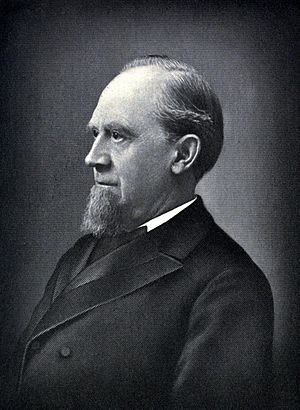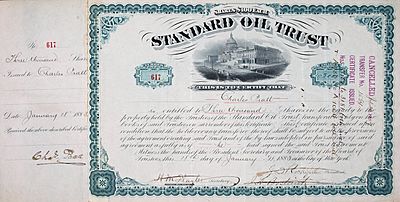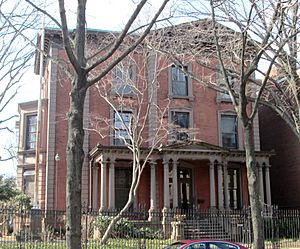Charles Pratt facts for kids
Quick facts for kids
Charles Pratt
|
|
|---|---|
 |
|
| Born | October 2, 1830 |
| Died | May 4, 1891 (aged 60) New York City, US
|
| Resting place | Pratt Cemetery, Glen Cove, New York, US |
| Nationality | American |
| Occupation | Businessman |
| Known for | Founded Pratt Institute |
| Spouse(s) |
Lydia Ann Richardson
(m. 1854; Mary Helen Richardson
(m. 1863) |
| Children | Charles Millard Pratt Lydia Richardson Pratt Helen Pratt Frederic B. Pratt George Dupont Pratt Herbert L. Pratt John Teele Pratt Harold I. Pratt |
Charles Pratt (born October 2, 1830 – died May 4, 1891) was an important American businessman. He was a leader in the early petroleum industry in the United States. Pratt started his own kerosene refinery called Astral Oil Works in Brooklyn, New York. He later teamed up with Henry Huttleston Rogers to form Charles Pratt and Company in 1867. Seven years later, their company joined John D. Rockefeller's large oil company, Standard Oil.
Charles Pratt cared a lot about education. He founded and supported the Pratt Institute in Brooklyn. Today, it is a famous college for art and design. He and his children also built large homes in Glen Cove, New York. This area later became known as the Gold Coast of Long Island. A large oil tanker was named after Charles Pratt in 1916.
Contents
Who was Charles Pratt?
Charles Pratt was born in Wilbraham, Massachusetts. He was one of eleven children. His father, Asa Pratt, was a carpenter. Charles studied for three winters at Wesleyan Academy. This school is now called Wilbraham & Monson Academy.
How did Charles Pratt start his career?
From Whale Oil to Petroleum
When he was young, Pratt worked for a company in Boston, Massachusetts. This company sold paints and products made from whale oil. In 1850 or 1851, he moved to New York City. There, he worked for a similar company.
Pratt soon realized something important. He saw that oil from the ground, called petroleum, could replace whale oil. Petroleum could be used to light lamps. As new oil wells opened in Pennsylvania in the 1860s, Pratt became a leader in the petroleum industry. In the 1860s, he started his own kerosene refinery. It was called Astral Oil Works and was located in Brooklyn, New York. One of his advertisements said, "The holy lamps of Tibet are primed with Astral Oil."
Partnering with Henry H. Rogers
Pratt met Henry Huttleston Rogers in the oil fields of Pennsylvania. This was in the mid-1860s. Pratt had bought whale oil from Rogers and his partner, Charles Ellis, before. Ellis and Rogers had a small oil business called Wamsutta Oil Refinery. They agreed to sell all their oil to Pratt's company at a set price.
However, Ellis and Rogers soon owed Pratt a lot of money. Ellis gave up, but Rogers went to Pratt in New York City in 1866. Rogers said he would pay back all the debt himself. Pratt was very impressed by Rogers. He immediately hired Rogers to work for his company. After working in the oil fields for five years, Pratt asked Rogers to come to Brooklyn. Rogers worked there for the next eight years. Pratt made Rogers the foreman of his Brooklyn refinery. He promised Rogers a partnership if sales went over $50,000 a year.
In 1867, Pratt and Rogers became partners. They started the company Charles Pratt and Company. A journalist named Elbert Hubbard said that Rogers became Pratt's "hands and feet and eyes and ears." In 1867, Pratt built "America's first modern oil refinery (Astral Oil)." It was located on the banks of Newtown Creek. In 1869, Pratt officially registered "Pratt's Astral Oil" as a trademark.
Joining Standard Oil
In the early 1870s, Pratt and Rogers faced problems with John D. Rockefeller's South Improvement Company. Rockefeller had secret deals with railroads. These deals gave him lower shipping prices than other oil companies. This made independent oil producers and refineries very angry.
Oil companies in New York formed a group. In March 1872, they sent a committee led by Rogers to Oil City, Pennsylvania. They worked with other independent oil companies. Rogers and his group made an agreement with the railroads. The railroads finally agreed to offer fair prices to everyone. They also promised to stop their special deals with South Improvement. The oil men felt they had won. But Rockefeller had already started buying up other oil companies to form Standard Oil.
Soon after, Rockefeller asked Charles Pratt to join his company. Pratt and Rogers decided that joining Standard Oil would be good for their business. Rogers worked out a deal that protected their money and jobs. Rockefeller accepted their terms. Charles Pratt and Company, including Astral Oil, became an important part of Rockefeller's company. They joined the Standard Oil Trust in 1874.
After joining Standard Oil, Pratt and Rockefeller began buying other oil refineries in Brooklyn. They used the Pratt name for these purchases. They managed to close down many smaller companies.
Fires and Later Business
Astral Oil had several fires in the 1870s and 1880s. On January 26, 1873, Pratt's Astral Oil-works in Williamsburg caught fire. About 250 people worked there at the time. No one died in the fire. Another fire happened on December 21, 1884, at the Brooklyn Astral refinery. Pratt said that most of the damage was covered by insurance.
Joining Rockefeller's company made Pratt very rich. He became a member of the board of directors of Standard Oil. But he often spoke out and criticized Rockefeller. When Pratt died in 1891, Rockefeller became even more powerful in the oil industry. Pratt's family continued to be involved in his businesses and with Standard Oil. His oldest son, Charles Millard Pratt (1855–1935), became the Secretary of Standard Oil. In 1923, his son Herbert Lee Pratt became the head of Standard Oil of New York.
What did Charles Pratt do for education?
Charles Pratt saw that the economy was changing. He realized there was a growing need for skilled workers. In 1886, he founded and supported the Pratt Institute. It opened in Clinton Hill, Brooklyn in 1887. At first, it was a technical school. Now, it is a famous college for art, design, and architecture.
In 1910, Pratt also helped pay for the building of the Pratt School of Naval Architecture and Marine Engineering. This school is part of the Massachusetts Institute of Technology. He also helped start the Emmanuel Baptist Church in Brooklyn. This church is still active today.
Charles Pratt's Family Life
Charles Pratt moved to New York in 1850 or 1851. In 1854, he married Lydia Ann Richardson (1835–1861). They had two children: Charles Millard Pratt (1855–1935) and Lydia Richardson Pratt (1857–1904). Sadly, Lydia Ann died young in 1861.
In September 1863, Pratt married Lydia's younger sister, Mary Helen Richardson. They had six children together: Frederic B. Pratt (1865–1945), Helen Pratt (1867–1949), George Dupont Pratt (1869–1935), Herbert L. Pratt (1871–1945), John Teele Pratt (1873–1927), and Harold I. Pratt (1877–1939).
Around 1890, Pratt moved to a country home in Glen Cove, New York. He bought a lot of land around his estate for his children. It was about 1,100 acres (4.5 square kilometers). He died the next year in New York City, at age 60. Each of his sons later built their own large homes in Glen Cove.
What is Charles Pratt's legacy?
Famous Mansions in Long Island
After Charles Pratt died, his six sons and two daughters built their own family estates in Glen Cove. These large homes are known as Gold Coast Mansions. Most of them are still used today:
- Welwyn, which belonged to Harold I. Pratt, is now a park and home to the Holocaust Memorial and Tolerance Center of Nassau County.
- The Braes, owned by Herbert L. Pratt, is now the Webb Institute of Naval Architecture and Marine Engineering.
- The Manor, built for John Teele Pratt, is now the Glen Cove Mansion Hotel & Conference Center.
- Poplar Hill, the home of Frederic B. Pratt, is now a healthcare center.
- Killenworth, which belonged to George Dupont Pratt, has been the country retreat for the Russian delegation to the United Nations since the mid-1900s.
Pratt Cemetery
The Pratt family had their own cemetery built in Glen Cove. It is called "Pratt Cemetery." Charles Pratt is buried there in a large stone tomb. Seven of his eight children and many of his grandchildren are also buried there.
Pratt, West Virginia
The town of Pratt, West Virginia, was renamed in 1905. It was named after the Charles Pratt Coal Company, which owned coal mines there.
The S.S. Charles Pratt Tanker
In March 1916, a large oil tanker was launched and named the S.S. Charles Pratt. It weighed 8,807 tons and could carry over 119,000 barrels of oil. It was the first ship of its kind. Another ship, the S.S. H.H. Rogers, was launched later that year.
During World War II, on December 21, 1940, the S.S. Charles Pratt was sunk by a German submarine. This happened in the Atlantic Ocean, about 220 miles (354 kilometers) off the coast of Africa. Out of the 42 American crew members, only two died.
Images for kids
See also
 In Spanish: Charles Pratt para niños
In Spanish: Charles Pratt para niños




